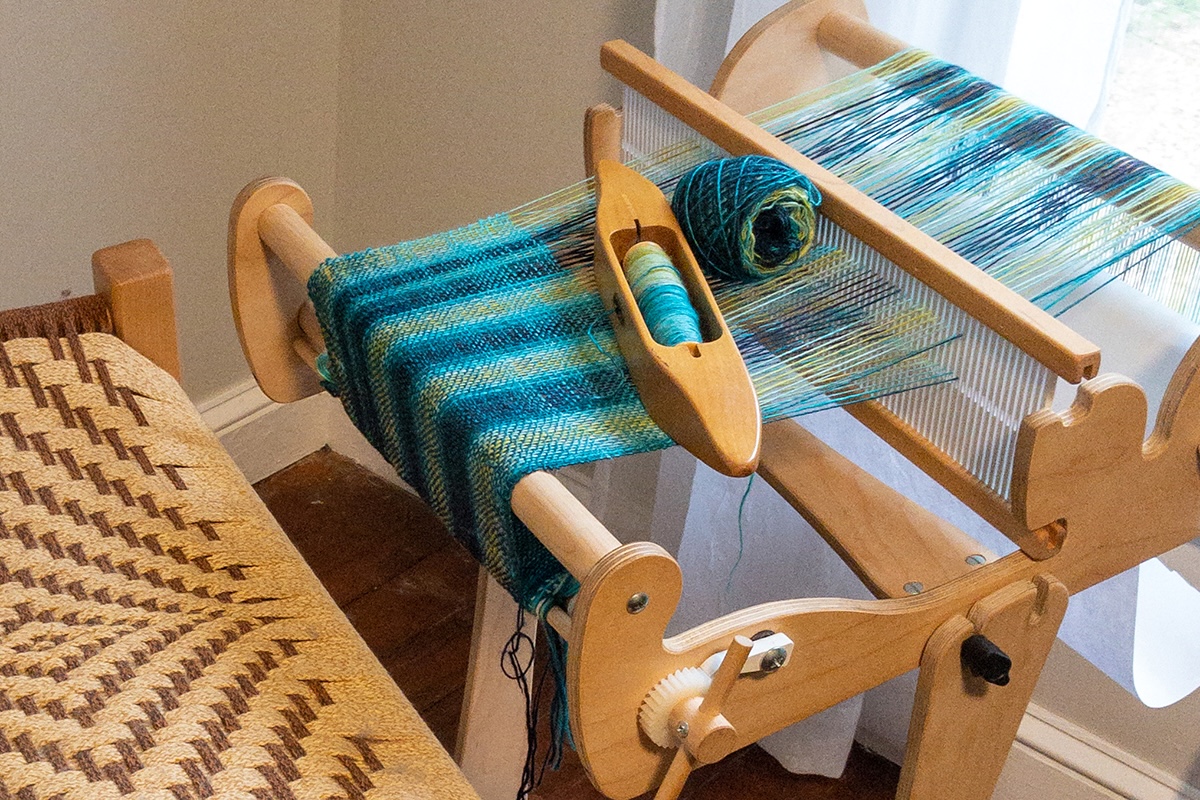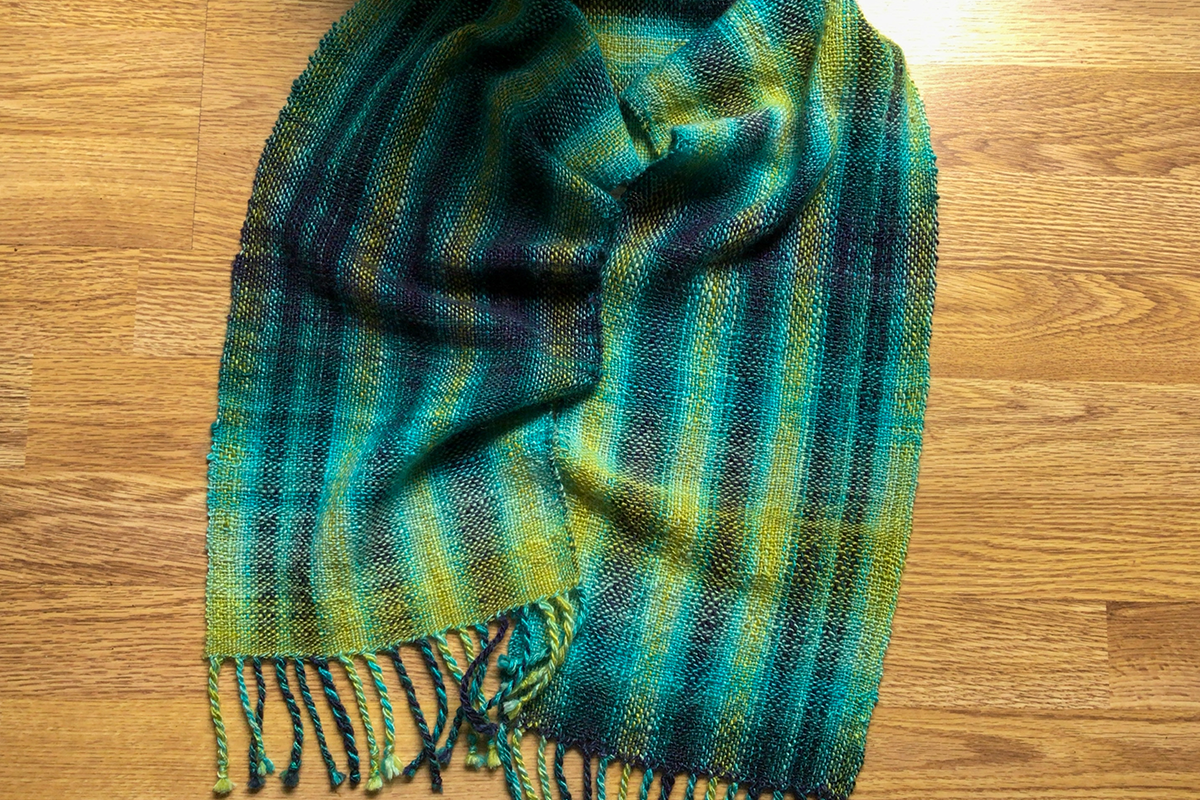The Rigid Heddle Loom Meets Handspun Singles
If you’re a handspinner who enjoys the rewards of knitting with your own yarn, odds are good that you’ve already experienced the unusual mathematics associated with any stashing endeavour: the rate of stash accrual is faster than the speed of knitting. While I will never decry the benefits of knitting with handspun, I’m all for enlisting alternate solutions in utilizing my handspun, and I know of no better stash-busting ally than the rigid heddle loom. It’s a user-friendly, forgiving partner in highlighting the handspun fruits of one’s fingertips.
Even a beginner can have their rigid heddle loom warped and ready to weave in no time, and a gift-worthy scarf can be off the loom in hours to days (vs. knitting’s weeks to months). A rigid heddle loom also leaves little in the way of warp waste, so it makes the most of precious yardage.

Schacht Cricket loom and stand are shown.
But perhaps the greatest perk to the rigid heddle loom, and the reason it’s the ideal pairing for handspun yarn, comes from this loom’s ingenious construction. The reed houses equally spaced heddles (as slots and holes) across its fixed frame, so the tensioning of each warp thread is absorbed across the entirety of the heddle itself. Also, tensioning the cloth-in-progress is more forgiving on this loom than it is on a floor or table loom. All of this means that you can weave a wide variety of yarns using the rigid heddle loom, including singles yarn, which is a favourite of mine for both spinning and weaving.
A Handspun & Handwoven Project
To prove this, I am using my go-to, trusty 5-inch Schacht Cricket Loom to weave a respectably sized scarf for my doctor. I’ll be using a singles yarn spun five years ago when I was still quite new to wheel spinning, which I came across recently. From past weaving experience, I know that using a singles spun from a repeat-dyed colourway as the warp yields a cloth with impressive vertical striping. Using the same yarn as the weft works well in creating a unified look. These singles are a *moderate twist and are not sized (meaning they have not been treated with any stabilizer, something that is usually needed to strengthen singles for floor loom warping). They are 20 wraps per inch (WPI) and 3200 yards per pound (YPP) and made from a 70/30 Polwarth/silk blend. I’m weaving a balanced plain weave structure.

Equipment/Supplies
- Rigid heddle loom, minimum 12 inches / 30 cm width
- 3.5 oz / 100 g of light-fingering to fingering weight handspun singles yarn, spun with a moderate twist
- Size 10 reed
- Stick shuttle or boat shuttle and bobbins
- Your preferred warping equipment and sley hook
- Snips or scissors
- Tapestry/darning needle
Basic Pattern
- Dimensions of the sample piece, on the loom
- Finished Length: 60 inches / 152 cm plus extra for loom waste/fringe
- Width: 11 inches / 28 cm
- Warp length: 75 inches 190 cm
- Number of warp threads: 110
- EPI: 10
Directions
- Test the yarn for strength by snapping several inches between your hands. It shouldn’t easily snap.
- Warp the loom using your preferred method; direct, indirect, or hybrid. Weave a few picks with waste yarn to separate the warp and weft threads.
- Add your singles yarn, leaving about three times the width of the warp for hemstitching. Make your hemstitch.
- Now weave! Beat each sett gently but firmly. The cloth will have a slightly open look to it, which will draw in when we finish it.
- Continue until you’ve reached the desired length of the scarf and/or the end of the warp.
- Using the remaining weft, hemstitch to finish.
Finishing
- Carefully cut the cloth from the loom.
- Twist your fringe prior to washing/finishing the cloth so the individual strands don’t fray or felt together while the cloth is soaking.
- Soak in warm water with a touch of gentle soap or wool wash, for 20 minutes.
- Roll the piece in a dry towel to remove excess water.
- Thwack the cloth to lock threads into place.
- Hang to dry. Snip ends.
Depending on the wool or wool blend used, you can expect an average of 10% shrinkage, both width and lengthwise.

Tips for Weaving with Singles Yarn
I have woven warp and weft using handspun singles for many years, trying different wools and blends. Here are some tips for singles success:
- Don’t spin too fine. A light-fingering weight yarn is my own thinnest preference for this application.
- Check your ply-back sample frequently for a light to moderate twist angle. You are spinning a singles, so aim for a ply-back with less twist than that needed for a 2-ply.
- Longwools and wool-silk blends make sturdy singles with great drape.
Final Thoughts
If you’ve been considering getting your own rigid heddle loom or you have one that’s not yet been put to use, try pairing it with your handspun. You’ll end up with a beautiful and functional accessory, or even cloth for sewing, while efficiently using yarn or fibre from stash.
For more information about basic rigid heddle weaving, including measuring for yardage needed, watch Felicia Lo’s course, Rigid Heddle Weaving Basics at the School of SweetGeorgia!
Original publication: July 7th, 2022; Refreshed: January 2nd, 2025
The post The Rigid Heddle Loom Meets Handspun Singles appeared first on SweetGeorgia Yarns.
Comments
Post a Comment